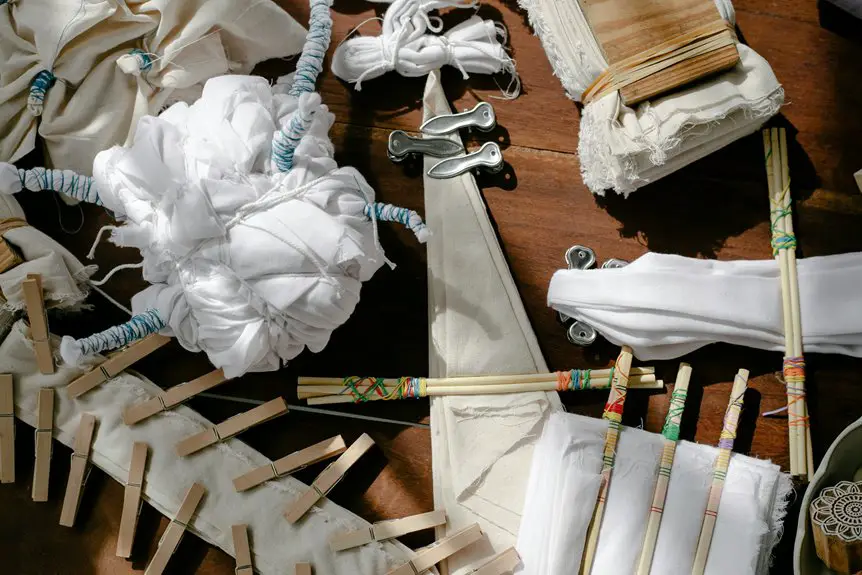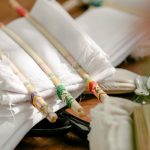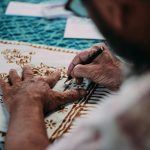Batik is a fabric art that uses a wax-resist dyeing technique to create stunning patterns. You apply hot wax to cloth, which blocks dye in certain areas, letting you craft intricate designs with vibrant colors. Traditionally made on cotton or silk, batik blends creativity and technical skill passed down for generations, especially in places like Indonesia. If you stick around, you’ll discover its rich history, unique styles, and how it holds cultural meaning worldwide.
Table of Contents
Key Takeaways
- Batik is a fabric dyeing method using wax to resist color, creating intricate patterns and designs.
- The technique involves applying hot wax to fabric, then dyeing to preserve wax-covered areas from color.
- Traditional batik primarily uses cotton or silk fabrics suitable for wax absorption and dyeing.
- Tools like canting (for fine lines) and cap (for larger patterns) are essential in wax application.
- Batik originated in ancient cultures and evolved notably in Indonesia, symbolizing cultural identity and artistry.
History and Origins of Batik
Although you might associate batik with Indonesia today, its history actually spans several ancient cultures. You’ll find early examples of wax-resist dyeing techniques in places like Egypt and India, dating back thousands of years.
This method allowed artisans to create intricate designs by applying wax to fabric before dyeing it, preventing color absorption in certain areas. Over time, batik evolved into a highly refined art form, especially in Java, Indonesia, where it gained cultural significance and unique regional patterns.
Wax-resist dyeing crafts intricate designs, blossoming into a celebrated art form with unique cultural patterns in Java.
As you explore batik’s origins, you’ll see how this craft reflects a blend of creativity, tradition, and technical skill that’s been passed down through generations across different parts of the world.
Batik’s rich history truly makes it a global artistic treasure.
Materials and Tools Used in Batik
To create authentic batik, you’ll need the right fabrics, usually cotton or silk, that absorb wax and dye well.
You’ll also use special tools like the canting, a small spouted pen, or a cap, a copper stamp, to apply wax precisely.
Knowing these materials and tools is key to mastering the batik process.
Essential Batik Fabrics
Choosing the right fabrics and tools is essential when you start batik dyeing. Cotton and silk are your best bets because they absorb wax and dye beautifully, giving you vibrant, lasting colors.
Cotton is durable and affordable, making it great for beginners, while silk offers a luxurious feel and brilliant sheen for more delicate designs. Avoid synthetic fabrics; they don’t hold wax or dye well, resulting in muted or uneven patterns.
Make sure your fabric is clean and tightly woven to prevent wax from bleeding through. Pre-washing removes sizing that might interfere with dye absorption.
Also, pick plain, light-colored fabrics to highlight your intricate batik designs effectively. With the right fabric, your batik art will truly come to life.
Wax Application Tools
Mastering wax application is key to creating detailed batik designs, and having the right tools makes all the difference.
You’ll primarily use a canting, a small copper tool with a spout that lets you draw fine, precise lines of hot wax onto your fabric. For larger areas, a brush or stamp (known as a cap) works best; caps are made from copper and carved with intricate patterns to transfer wax quickly and consistently.
You’ll also need a wax pot to melt your wax safely and maintain the right temperature, ensuring smooth flow. Together, these tools help you control the wax’s placement and thickness, which directly affects your final design’s clarity and texture.
Using them properly elevates your batik work considerably.
Step-by-Step Batik Making Process
Now that you know the materials and tools, it’s time to prepare your fabric and get your workspace ready.
You’ll start by applying hot wax to create your design, which protects certain areas from dye.
Once the wax is set, you’ll carefully apply the dye to bring your pattern to life.
Preparing Fabric and Tools
Before you plunge into applying wax and dye, you’ll need to prepare both your fabric and tools carefully.
Start by choosing natural fabrics like cotton or silk, as they absorb dye best. Wash your fabric thoroughly to remove any sizing, oils, or dirt that might block the wax or dye from adhering properly. Let it dry completely.
Meanwhile, gather your essential tools: a canting (a small spouted tool) or tjanting for applying wax, a wax pot to melt your beeswax or paraffin, and dye containers.
Set up a clean, flat workspace with newspaper or protective sheets. Make certain your wax stays at the right temperature—fluid but not too hot—to guarantee smooth application.
Preparing thoughtfully sets the foundation for successful batik creation.
Applying Wax and Dye
Start by heating your wax until it’s fluid enough to flow smoothly from your canting or tjanting.
Carefully draw your desired patterns on the fabric with the hot wax, ensuring you cover areas meant to resist dye. Let the wax dry completely, creating a protective barrier.
Next, immerse your fabric in the dye bath, allowing the exposed areas to absorb the color. After dyeing, dry the fabric, then apply more wax to sections you want to keep in the current color before dipping it in a different dye.
Repeat this wax-and-dye process to build intricate, multi-colored designs. Finally, remove the wax by boiling or scraping, revealing vivid patterns formed by the resist technique.
Handle the fabric gently throughout to preserve your detailed work.
Different Styles and Patterns in Batik
Patterns and styles in batik reflect the rich cultural heritage and creativity behind each piece. When you explore batik, you’ll notice a variety of motifs, from geometric shapes to intricate florals and animal designs.
Each region has its own signature style—Javanese batik often features symmetrical patterns with symbolic meanings, while Balinese batik tends to be more vibrant and free-form.
You’ll also find modern batik that blends traditional techniques with contemporary designs. As you create or appreciate batik, pay attention to how the wax lines define shapes and how colors layer to build depth.
Understanding these different styles helps you see batik not just as fabric but as a storytelling medium rich with artistic expression.
Cultural Significance of Batik Around the World
Batik carries deep cultural significance that goes beyond its visual appeal. When you explore batik, you uncover stories and traditions woven into every pattern.
Here’s how batik resonates globally:
- In Indonesia, batik symbolizes identity and social status, often worn during ceremonies.
- Malaysia uses batik to express cultural heritage, blending indigenous and colonial influences.
- In West Africa, batik designs convey messages and social commentary through vibrant colors.
- In India, batik reflects spiritual beliefs and is used in rituals and festivals.
Modern Applications and Revival of Batik Art
Although rooted in tradition, the art of batik has found fresh life in modern fashion and home décor, appealing to new generations worldwide.
When you explore contemporary batik, you’ll see designers incorporating its intricate patterns into everything from clothing to accessories, blending classic techniques with modern aesthetics.
You can also bring batik into your living space through textiles like pillows, curtains, and wall hangings that add a unique, handcrafted touch.
Many artists and crafters are reviving batik by experimenting with new dyes, materials, and methods, keeping the craft vibrant and relevant.
Frequently Asked Questions
How Long Does It Take to Complete a Batik Piece?
Completing a batik piece can take you anywhere from several hours to weeks, depending on your design’s complexity and size. You’ll patiently apply wax, dye, and repeat until your artwork’s vibrant and detailed enough.
Can Batik Be Made Using Synthetic Fabrics?
You can make batik on synthetic fabrics, but the wax and dyes may not adhere or react well compared to natural fibers. You’ll get better results using cotton or silk, which absorb wax and dye more effectively.
Is Batik Environmentally Friendly?
You’ll find batik can be eco-friendly if natural dyes and sustainable fabrics are used. However, synthetic dyes and chemicals may harm the environment, so it depends on the materials and methods you choose during production.
How Do You Care for and Wash Batik Clothing?
You should wash batik clothing gently, like cradling a fragile flower. Use cold water and mild detergent, avoid wringing, and air dry in the shade to keep colors vibrant and fabric soft for longer.
Are There Famous Artists Known Specifically for Batik?
You’ll find famous batik artists like Iwan Tirta from Indonesia, who popularized batik globally. Also, Affandi incorporated batik into his paintings. These artists helped you appreciate batik as both craft and fine art.
- Folding and Binding: The Core of All Tie-Dye Techniques - July 13, 2025
- The Complete Guide to Natural Dyeing Techniques - July 13, 2025
- How to Set Up Your Tie-Dye Station for Easy Cleanup - July 13, 2025







